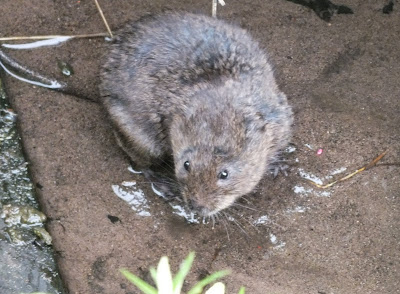


Degraded latrines can be hard to see.

Unusually long water vole droppings. Generally they're shorter than this, more Tic-tac-shaped.

Definitely too chunky for field vole feeding!

Arguably latrines are the most important field sign of all. Not only are water vole droppings the most unambiguous sign of w-v presence - given that small feeding stations can be confused with those of field voles; burrows and footprints can be rats'; even sightings of the animals themselves aren't always clear as rats and f-vs swim about in a similar way to w-vs - but also the theory is that latrines can be used to estimate populations. This is because the female voles use them as territorial markers during the breeding season.
A formula has been developed which allows the number of water voles to be estimated from the number of latrines found: y = 1.48 + 0.683x where x = latrines counted and y = water voles (Morris et al., 1998).
However, when you're doing surveys it's easy to miss latrines because droppings are often mud-coloured (though they can also be dark greenish or almost black). In addition, they'll probably have been at least partly trampled flat by the female to spread the scent around - kind of like drawing an emphatic border round your 'Trespassers will be prosecuted' notice. So you need to really part the grass and get right down to earth level. Look for even slight discolourations to the soil, as in picture 3, and use camera zoom or binoculars to study likely-looking but inaccessible patches of bank. Water voles often like to use a raised or prominent area for a latrine, so a little spur of earth jutting out into the stream is a good place to look, or some protruding rubbish (polystyrene tiles and broken-off fence posts dropped into the water seem popular). I've even seen them on mole hills.
And remember that the calculation is only as good as the number of latrines you actually uncover. It may be you've missed half, or even more.













































